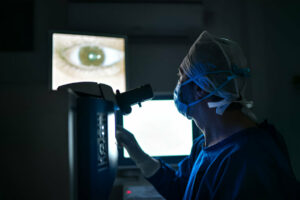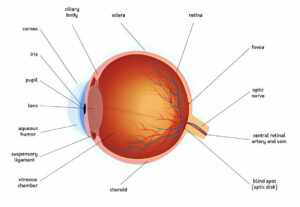
Children may not realize they have eye issues if symptoms are subtle. Therefore, it’s essential that parents get their child screened regularly at pediatric appointments and watch out for signs like wandering eyes (strabismus), amblyopia, lazy eye syndrome and refractive errors like myopia nearsightedness and hyperopia farsightedness.
Strabismus
Strabismus, or eye misalignment, affects millions of children worldwide and can result in double vision, decreased depth perception and other visual impairments. Strabismus may present itself at birth or develop later as the result of an anatomical defect, neurological problem, eye muscle weakness or other medical condition – including side effects from certain medications; those living with strabismus also face an increased risk for health conditions like Down syndrome, cerebral palsy and stroke.
Strabismus can be identified based on its direction and frequency of misalignments. Most commonly seen among children is crossed eyes (esotropia). A child may also have one eye turn either inward toward or away from the nose (incyclostrabismus or walleyes or exotropia).
Six external eye muscles control each eye’s movement and positioning. When these muscles work together properly, binocular vision results – in which two eyes provide one image that the brain then uses to give depth perception and three dimensional sight. If any one of the six eye muscles becomes weak or overactive or otherwise compromised, binocular vision cannot occur; many types of strabismus may arise in response, with congenital, infantile, or acquired forms all possible forms presenting after 6 months but before complete visual development (approximately age 8).
Children who suffer from strabismus are at an increased risk for amblyopia, in which the brain disregards information from one eye in favor of its counterpart eye, which can result in permanent vision loss unless treated and monitored until visual acuity and depth perception have reached acceptable levels. It is recommended that all children be examined prior to entering preschool and periodically thereafter by either their pediatrician/family practitioner trained in assessing preschool children, or an ophthalmologist for assessments if screenings fail.
Amblyopia
Amblyopia, more commonly known as lazy eye, occurs when one or both eyes fail to receive adequate input from the visual system. Amblyopia is a common problem among children and can result in permanent vision loss if left untreated. Children diagnosed with Amblyopia should be evaluated by a Doctor of Optometry as soon as possible to ascertain both its cause and recommended treatments for it.
Amblyopia can often be traced back to misalignments between the eyes, known as Strabismus. This condition can occur either when one or both eyes turn in (esotropia) or out (exotropia). Children suffering from strabismus have poor binocular vision as they cannot depend on information from one eye for clear images.
Amblyopia often develops due to an irregularity in the structure of an eye that alters how it sees, such as cataracts, corneal irregularities, lens abnormalities or even tumors. When this happens, the brain can ignore input from this eye leading to amblyopia development.
Early treatment for amblyopia increases its chance of being reversed as brain plasticity means visual pathways can still change over time.
One approach to treating amblyopia is wearing an eye patch over one’s good eye for weeks or months; this forces its weak eye to work and improves vision; however, many amblyopic patients do not respond favorably to this form of treatment.
Newer methods of amblyopia treatment are now producing promising results. For instance, children can now use action video games to stimulate and strengthen weak eyes, and improve vision – this approach has proven more successful than simply covering strong ones with eyewear or patching alone. When combined with corrective eyewear or patching therapy and corrective eyewear or patching for occlusion therapy occlusion therapy can significantly increase children who achieve good vision in amblyopic eyes – therefore making early diagnosis and treatment important if the condition can reverse itself – thus it must be diagnosed and addressed before critical time has elapsed for success reversing this condition has passed!
Glaucoma
Glaucoma is a sight-threatening eye condition caused by increased eye pressure. This increases strain on the optic nerve which transmits visual information from eye to brain and damages its health. Glaucoma affects people of any age; though older adults seem particularly at risk. Higher blood pressure increases risks as does family history of the condition as does African American heritage; genetic disorders like Sturge-Weber syndrome or Aniridia also increases chances of Glaucoma developing.
Children must be encouraged to attend regular follow-up visits. Adherence can be challenging in young patients and it is sometimes difficult to know whether their medication is actually controlling glaucoma effectively; thus a comprehensive history should be taken, including review of medications taken and family medical history.
Comprehensive eye examination is necessary, including slit lamp analysis of cornea and lens structure, optic discs, cup-disc ratio and focal areas of rim loss. Agonioscopy may also be beneficial in children to assess the shape of anterior chamber and drainage canals; its frequency varies based on age, history and IOP – with more frequent evaluations required in infants.
Glaucoma treatment typically includes medication and surgery. Common surgical approaches include goniotomy, trabeculotomy and laser glaucoma surgery to lower eye pressure; for children aged four or five a tube shunt may also help drain fluid away from their eye and reduce pressure.
Genetic evaluation is crucial when diagnosing childhood glaucoma due to PAX6 mutations or FOXC1 duplications, since their incidence of glaucoma increases dramatically and they can result in various eye phenotypes. Screening for consanguinity has been reported as increasing prevalence rates for primary congenital glaucoma.
Eye Infections
Eyes are constantly exposed to bacteria, but tear defense mechanisms help guard against infection. When an infection does arise, however, watery discharge usually produces thick mucous that irritates and mattes together the eyelids; this condition is called bacterial conjunctivitis and it most frequently strikes children when in communal settings like school, summer camp and playgrounds.
Conjunctivitis can be very contagious, requiring your child to stay home from school and other social activities until they receive clearance from their physician. Gently washing eyes with warm water soaked washcloths before applying antibiotic eyedrops or ointment may provide temporary relief; some doctors also provide oral antibiotic prescription.
Pink Eye (Conjunctivitis) can have many causes; healthcare professionals will evaluate patient history and symptoms to diagnose it accurately. Viral: Viral conjunctivitis is usually contagious but typically resolves itself within several days without treatment. Chemical exposure such as perfumes, sprays or household cleaners may irritate and redden eyes as well as increase light sensitivity.
Blepharitis: This condition causes bilateral irritation, itching, hyperemia and crusting of eyelid margins and lashes accompanied by bilateral irritation, itching, hyperemia and crusting of eyelid margins and lashes. Common associated disorders include rhinitis and eczema. Meibomian gland dysfunction causes itching, stinging and hyperemia of lid rims which may progress to become chalazion-forming lesions.
No matter the cause, all forms of pink eye require medical evaluation and treatment early to avoid spreading it to other people and make your child feel better. Opiates and eyedrops prescribed by healthcare providers are effective ways of killing bacteria causing infections; regularly using cotton swabs soaked with warm water for cleaning the crusting can also help. Tinted glasses may provide additional relief against bright light; artificial tears may help ease inflammation and itching as well.














